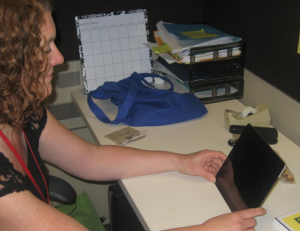
Video-based modules are a type of technology-aided instruction and intervention. Learners with ASD (Autism Spectrum Disorder) may benefit from visual supports and interventions utilizing technology. Instructional modules can be utilized to teach specific skills to improve daily living, work productivity, problem solving, and/or social communication skills. Technology-aided instruction and intervention is considered an evidence-based practice for individuals with ASD ages 3-22 (Wong et al., 2015) and can include components of video modeling. Video-based modules can be played on a variety of devices including smart phones, iPads, laptops, and desktops.
Below are several examples of studies that examine the effectiveness of utilizing modules:
- Cihak, D., Fahrenkrog, C., Ayres, K. M., & Smith, C. (2010). The use of video modeling via a video iPod and a system of least prompts to improve transitional behaviors for students with autism spectrum disorders in the general education classroom. Journal of Positive Behavior Interventions, 12, 103-115.
- Video prompts delivered via iPods were utilized to support independent transitions to different activities and settings within an elementary school for four elementary students with autism. The independent transitions of students improved from 7% to 77% after the introduction of the video-modeling intervention.
- Golan, O., & Baron-Cohen, S. (2006). Systemizing empathy: Teaching adults with Asperger syndrome or high-functioning autism to recognize complex emotions using interactive multimedia. Development and Psychopathology, 18, 591-617.
- An interactive guide to emotions called Mind Reading (Baron-Cohen, Golan, Wheelwright, & Hill, 2004) was utilized to improve the emotional recognition tasks of adults with autism. Results indicated adults who had used the interactive media for 10-15 weeks improved in their ability to recognize complex emotions.
- Hopkins, I. M., Gower, M. W., Perez, T. A., Smith, D. S., Amthor, F. R., Wimsatt, F. C., & Biasini, F. J. (2011). Avatar assistant: Improving social skills in students with an ASD through a computer-based intervention. Journal of Autism and developmental disorders, 41, 1543-1555.
- Students with low-functioning and high-functioning autism improved their ability to attend to eye gaze, discriminate facial expressions, and recognize faces through an interactive, realistic avatar assistant. The program was a computer-based social skills training program.
- Mason, R. A., Davis, H. S., Boles, M. B., & Goodwyn, F. (2013). Efficacy of point-of-view video modeling: A meta-analysis. Remedial and Special Education, 34, 333-345.
- A meta-analysis of single-case design studies was conducted to examine the efficacy of point-of-view video modeling (POV), which is utilized in the ASD On The Go instructional modules. POV increased independence among adolescents and young adults with developmental disabilities and autism.
- Mineo, B. A., Ziegler, W., Gill, S., & Salkin, D. (2009). Engagement with electronic screen media among students with autism spectrum disorders. Journal of Autism and Developmental Disorders, 39, 172-187.
- Four different types of screen media were examined to determine which were most engaging for students with autism: animated video, video of self, video of a known person engaged in a virtual reality game, and immersion of self in the virtual reality game.
- Richter, S., & Test, D. (2011). Effects of multimedia social stories on knowledge of adult outcomes and opportunities among transition-aged youth with significant cognitive disabilities. Education and Training in Autism and Developmental Disabilities, 410-424.
- Multimedia social stories were utilized to support the transition goals of three young adults with cognitive disabilities. The multimedia social stories were about adult outcomes and opportunities, such as obtaining employment and participating in leisure activities.
- Silver, M., & Oakes, P. (2001). Evaluation of a new computer intervention to teach people with autism or Asperger syndrome to recognize and predict emotions in others. Autism, 5(3), 299-316.
- A multimedia computer program was developed to teach individuals with autism to recognize emotions in others. Children who received the computer program intervention scored higher on measures related to predicting the emotions of others.
